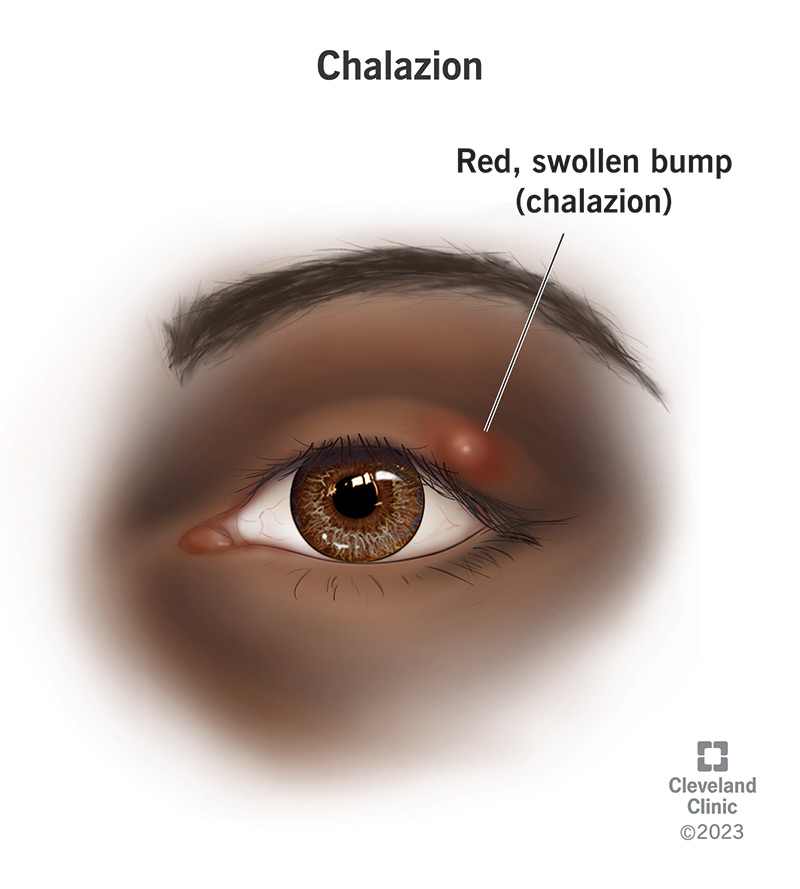A chalazion is a swollen, pain-free bump on your eyelid. Your eyelid has tiny glands that produce an oily substance to help keep your eyes moist. When one of those glands gets blocked, you can wind up with a chalazion. Usually, you can treat a chalazion at home.
Advertisement
Cleveland Clinic is a non-profit academic medical center. Advertising on our site helps support our mission. We do not endorse non-Cleveland Clinic products or services. Policy

A chalazion is a red bump on your eyelid. It’s sometimes called an eyelid cyst or a meibomian cyst. It slowly forms when an oil gland (called a meibomian gland) becomes blocked. At first, the chalazion may be painful, but after a little time, it usually doesn’t hurt. A chalazion typically forms on the underside of your upper eyelid but may occasionally form on your lower eyelid.
Advertisement
Cleveland Clinic is a non-profit academic medical center. Advertising on our site helps support our mission. We do not endorse non-Cleveland Clinic products or services. Policy
Ordinarily, chalazia (the plural of chalazion) develop in adults between the ages of 30 and 50. They’re not common in children, but they can happen.
It can be hard to tell the difference between a chalazion and a stye. A chalazion can form because of a stye, but they’re different conditions. While they both form due to blocked oil glands, styes are bacterial infections that cause the gland to swell. Styes appear at your eyelid’s edge, whereas chalazia appear farther back on your eyelid. In addition, styes can be painful, but chalazia generally aren’t painful.
If you have a chalazion, you’ll notice a bump on your eyelid. It usually affects your upper lid. When a chalazion first develops, it may be painful, but the pain will quickly go away. As the chalazion grows, it may become red, swollen and tender.
Other chalazion symptoms may include:
A chalazion develops when something blocks a small oil gland in your eyelid. These glands (meibomian glands) help keep your eyes moist. A blocked gland begins retaining oil and swells. Eventually, the fluid will drain, causing irritation to your surrounding eyelid skin. This irritation can lead to a hard lump filled with the oil and fluid on your eyelid.
Advertisement
No, chalazia aren’t contagious. Bacterial infections don’t cause them, so bacteria can’t spread from person to person.
Chalazia are very common, and anyone can get them. But you may be more likely to get a chalazion if you:
Larger chalazia can press on the surface of your eye (cornea), which can lead to blurred and decreased vision.
You’ll usually see an eye care specialist when you have a chalazion. You might see an optometrist or an ophthalmologist. These healthcare providers can examine the chalazion and offer treatment options.
When you see an eye care specialist, you can expect:
In most cases, you can treat a chalazion at home. Most chalazia go away in a month or less.
First, never push on a chalazion or try to pop it. You can cause inflammation and infection. Instead, for chalazion self-care, try:
If the chalazion doesn’t go away, you should seek help from an eye care specialist. Chalazion treatment in your provider’s office may include draining the fluid through a small cut (incision). You may also need an injection of steroids to reduce swelling and inflammation.
With proper home management, a chalazion should heal in a week. If left untreated, it can take four to six weeks for the chalazion to heal. Some can persist for many months.
If you have one chalazion, you may get another. Always practice good hygiene to help prevent future chalazia.
Some chalazia form because of styes. You may be able to avoid getting a chalazion if you can avoid getting a stye. You can avoid getting styes by following good hygiene. Some essential elements of good hygiene include:
Advertisement
If you have a chalazion that doesn’t go away with home treatment, see an eye care specialist. They’ll be able to examine your eye and offer additional treatment options. You should also see your healthcare provider if you have recurring chalazia (eyelid bumps that come back).
If you have a chalazion, you may want to ask your provider:
Advertisement
Keeping your eyes healthy is important for your vision and quality of life. Sometimes, though, things like chalazia — a swollen, pain-free bump on your eyelid — happen. While this eye condition can be worrisome, chalazia aren’t usually a cause for concern and are very treatable at home. Most cases go away on their own with self-care and good eyelid hygiene. If a chalazion persists and doesn’t seem to be getting any better, contact your eye care specialist.
Advertisement
Cleveland Clinic’s ophthalmologists and optometrists have the highest training available. We provide exams, vision correction and care for many eye conditions.

Last reviewed on 01/08/2024.
Learn more about the Health Library and our editorial process.